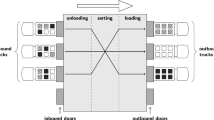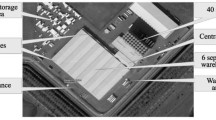Abstract
The truck plant of General Motors of Canada produces 60 trucks/hour, 2 shifts/day, in a highly automated factory employing 3,200 people. Flow in the paint shop is prone to bottlenecks when there is a large ratio of two- to monotone jobs. (Two-tone jobs require a second pass through the paint shop.) The shop has four major control points (two conveyor crossovers and two significant conveyor intersections), where decisions for routing jobs can greatly impact paint-shop performance. A simulation model is developed and refined to determine a set of “best” rules for those control points, dynamic rules reflecting input variables, and current system status. The paint-shop simulation model is employed to study overall throughput and time in the system for various control rules, as functions of product mix and the rates of automotive processing and repair. Conclusions are drawn regarding the influence of those rules on the conveyor crossovers and intersections.
Similar content being viewed by others
References
Agnetis A, Pacifi A, Rossi F (1997) Scheduling of flexible flow lines in an automobile assembly plant. Eur J Oper Res 97(2):348–362
AlDurgham MM, Barghash MA (2008) A generalised framework for simulation-based decision support for manufacturing. Prod Plan & Control 19(5):518–534
Álvarez-Caldas C, Quesada A, Gauchía A, San Román JL (2009) Expert system for simulation of metal sheet stamping. Eng Comput 25(4):405–410
Banks J, Carson II JS, Nelson BL and Nicol DM (2010) Discrete-event system simulation, 5th edn. Prentice-Hall, Upper Saddle River
Bock S, Rosenberg O, van Brackel T (2006) Controlling mixed-model assembly lines in real time by using distributed systems. Eur J Oper Res 168(3):880–904
Bookbinder JH, Kirk MD (1997) Lane selection in an AGV-based asynchronous parallel assembly line. Comput Ind Eng 32(4):927–938
Boysen N, Fliedner M, Scholl A (2009) Production planning of mixed-model assembly lines: overview and extensions. Prod Plan & Control 20(5):455–471
Boysen N, Scholl A, Wopperer N (2012) Resequencing of mixed-model assembly lines: survey and research agenda. Eur J Oper Res 216(3):594–604
Ching SN, Meerkov SM, Zhang L (2008) Assembly systems with non-exponential machines: throughput and bottlenecks. Nonlinear Anal 69(3):911–917
Duplaga EA, Hahn CK, Hur D (1996) Mixed-model assembly line sequencing at Hyundai Motor Company. Production & Inventory Management 37(3):20–25
Fisher ML, Ittner CD (1999) The impact of product variety on automobile assembly operations: empirical evidence and simulation analysis. Manag Sci 45(6):771–786
Gnoni MG, Iavagnilio R, Mossa G, Mummolo G, Dileva A (2003) Production planning of a multi-site manufacturing system by hybrid modeling: a case study from the automotive industry. Int J Prod Econ 85(2):251–262
Han Y-H, Zhou C, Bras B, McGinnis L, Carmichael C, Newcomb PJ (2003) Paint line color change reduction in automobile assembly through simulation. In: Chick S et al. (eds) Proceedings of the 2003 Winter Simulation Conference, pp 1204–1209
Jahangirian M, Eldabi T, Naseer A, Stergioulas LK, Young T (2010) Simulation in manufacturing and business: a review. Eur J Oper Res 203(1):1–13
Jin M, Luo Y, Eksioglu SD (2008) Integration of production sequencing and outbound logistics in the automotive industry. Int J Prod Econ 113(2):766–774
Joly A, Frein Y (2008) Heuristics for an industrial car sequencing problem considering paint and assembly shop objectives. Comput Ind Eng 55(2):295–310
Law AM (2014) Simulation modeling and analysis, 5th edn. McGraw-Hill, New York
Li J (2004) Throughput analysis in automotive paint shops: a case study. IEEE Trans Autom Sci Eng 1(1):90–98
Li J, Blumenfeld DE, Marin SP (2008) Production system design for quality robustness. IIE Trans 40(3):162–176
Lou HH, Huang YL (2003) Hierarchical decision making for proactive quality control: system development for defect reduction in automotive coating operations. Eng Appl Artif Intell 16(3):237–250
Masmoudi W, Chtourou H, Maalej AY (2007) Labor and machine sizing through a simulation-expert-system-based approach. Simul Model Pract Theory 15(1):98–110
Muhl E, Charpentier P, Chaxel F (2003) Optimization of physical flows in an automotive manufacturing plant: some experiments and issues. Eng Appl Artif Intell 16(4):293–305
Ockerman DH, Goldsman D (1999) Student t-tests and compound tests to detect transients in simulated time series. Eur J Oper Res 116(3):681–691
Park YH, Matson JE and Miller DM (1998) Simulation and analysis of the Mercedes-Benz all activity vehicle (AAV) production facility, Proceedings of the 1998 Winter Simulation Conference, pp 921–926
Resano Lázaro A, Luis Pérez J (2009) Dynamic analysis of an automobile assembly line considering starving and blocking. Robot Comput Integr Manuf 25(2):271–279
Ribeiro CC, Aloise D, Noronha TF, Rocha C, Urrutia S (2008) A hybrid heuristic for a multi-objective real-life car sequencing problem with painting and assembly line constraints. Eur J Oper Res 191(3):981–992
Sargent RG (2013) Verification and validation of simulation models. J Simul 7(1):12–24
van der Zee DJ (2006) Modeling decision making and control in manufacturing simulation. Int J Prod Econ 100(1):155–167
Yalcin A, Namballa RK (2005) An object-oriented simulation framework for real-time control of automated flexible manufacturing systems. Comput Ind Eng 48(1):111–127
Author information
Authors and Affiliations
Corresponding author
Rights and permissions
About this article
Cite this article
Bookbinder, J.H. Dynamic control rules for conveyor intersections in a truck-assembly paint shop. Int J Adv Manuf Technol 76, 1515–1527 (2015). https://doi.org/10.1007/s00170-014-6235-3
Received:
Accepted:
Published:
Issue Date:
DOI: https://doi.org/10.1007/s00170-014-6235-3




